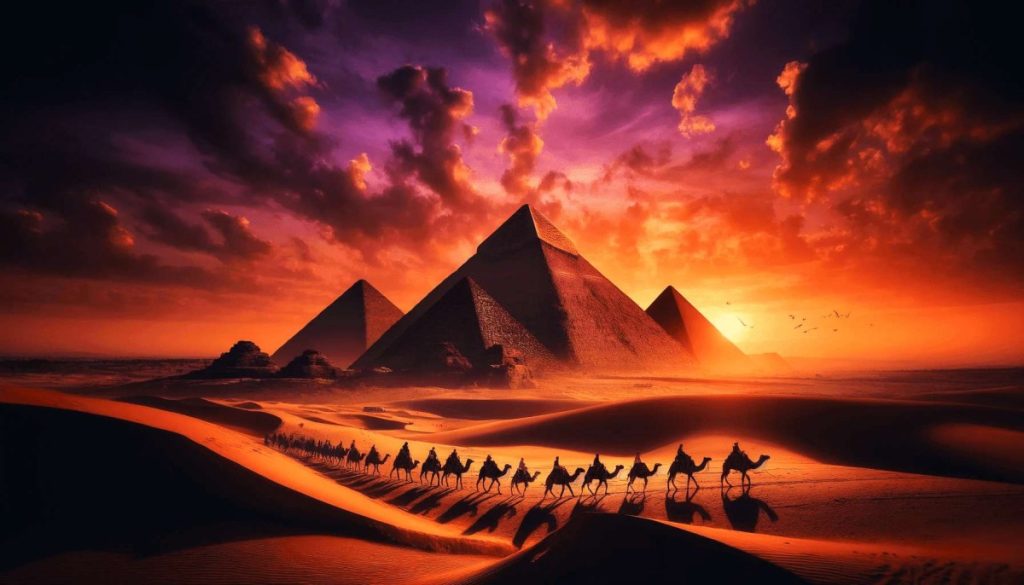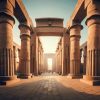An Introduction to Iconic Places in Egypt
Embark on an unparalleled journey through the sands of time and the heartbeats of civilizations past with our meticulously curated exploration of Egypt’s astounding treasures. From the whispering sands of the Sahara to the vibrant banks of the Nile, Egypt unfurls a tapestry of destinations so rich and diverse, it promises to captivate the soul of every traveler. As an experienced tour guide turned travel writer, I’ve journeyed the length and breadth of this historic land, from its northern shores to its southernmost tips, gathering over 150 gems that showcase the incredible tapestry of places in Egypt one can visit.
In this grand adventure, we’ll delve into the heart of Egypt’s grandeur, categorized into four enthralling sections:
The mystique of Archaeological Historical Sites, the profound beauty of Museums and Collections, the divine whispers of Temples, Mosques, and Religious Sites, and the solemn echoes of Tombs and Necropolises. Each category not only stands as a testament to Egypt’s rich legacy but also as a doorway to understanding the complexity and depth of its culture and history.
Now, let’s talk about time—a commodity you’ll wish you had an ocean of as you embark on this epic journey. Visiting these wonders is no small feat; indeed, to fully immerse yourself in the majesty of Egypt’s treasures could take you anywhere from a whirlwind three to a leisurely six months. But fret not, for I jestingly propose a solution so simple yet so daring: why not make Egypt your second home? With each visit, from the first to the perhaps tenth, you’ll peel back another layer of its endless mystery, each layer as rich and surprising as the last.
So, dear reader, whether you’re a history buff, a culture enthusiast, or simply in search of beauty that transcends time, I invite you to lace up your most comfortable walking shoes, pack an extra suitcase for memories, and perhaps consider an extended lease on a charming Nile-side residence. Egypt’s timeless wonders await, and I assure you, the journey through its heart is one that transforms not just your travel album, but your very soul. Let’s set sail on this adventure together, discovering the stories, secrets, and splendors that only Egypt can offer. Welcome to a voyage into the heart of ancient wonders and modern marvels—welcome to the journey of a lifetime.
Archaeological and Historical Sites
Embarking on the journey through Egypt’s Archaeological and Historical Sites is akin to stepping through the pages of a living history book, each chapter more mesmerizing than the last. With 76 sites spread from the whispering dunes of the east to the setting sun in the west, and from the fertile delta in the north to the majestic Nubian landscapes in the south, this collection represents the pinnacle of human achievement and perseverance. Laid out alphabetically, they offer a roadmap not just through places, but through time itself, inviting you to walk in the footsteps of pharaohs, soldiers, craftsmen, and the many souls who shaped the destiny of this ancient land.
As we begin our alphabetical odyssey, imagine the stories etched into each stone and the echoes of ancient conversations carried by the wind. These sites, ranging from towering pyramids that pierce the sky to the ruins of cities once bustling with life, stand as guardians of history. They are the custodians of Egypt’s glorious past, each with its own tale of grandeur, conquest, faith, and innovation.
Here, in the realm of Archaeological and Historical Sites, you’ll encounter the legendary Pyramids of Giza, standing as eternal testaments to Egypt’s architectural and engineering prowess. Journey onwards to Abu Simbel, where the colossal statues of Ramses II gaze out over the land, their silent vigil a powerful reminder of the pharaoh’s might and the artistic ingenuity of the ancients. Not far behind, the enchanting ruins of Alexandria’s ancient library whisper the secrets of a place where the world’s knowledge once converged.
As we travel through this alphabetical guide, from Abydos with its mysteries of the afterlife to the Zoser’s Step Pyramid, the world’s earliest colossal stone building, each site invites you to pause and reflect on the layers of history beneath your feet. Luxor stands as an open-air museum, boasting an unparalleled collection of historical sites in its confines, including the majestic Karnak Temple and the Valley of the Kings, the final resting place of Egypt’s rulers, shrouded in mystery and allure.
But let’s not forget the less sung heroes of our journey – the remote oases, such as Siwa, home to the Oracle of Amun, which Alexander the Great once visited; or the Serapeum of Saqqara, a subterranean necropolis that held the sacred Apis bulls, linking the divine to the earthly in ways that continue to fascinate.
As we alphabetically chart these 76 keystones of Egypt’s archaeological and historical heritage, remember, each site is a doorway to a story untold, a puzzle piece of humanity’s grand narrative. From the bustling streets of ancient Thebes to the serene, timeless beauty of Philae’s island temple, this journey is a treasure hunt without parallel, where every discovery is a jewel in the crown of Egypt’s majesty.
So, dear traveler, arm yourself with curiosity and a sense of wonder as vast as the Sahara. For in the exploration of Egypt’s Archaeological and Historical Sites, you are not merely a visitor, but a witness to the saga of human civilization itself, etched in stone and sand, waiting for you to unveil its secrets. Welcome to the adventure of a lifetime; welcome to the heart and soul of Egypt.
Certainly, here’s a concise introduction to each of the sites mentioned:
Al Ashmunein (Ancient Hermopolis)
Facts: Once a major city named Khmun, and later known as Hermopolis in the Greco-Roman period, it was revered as the center of worship for Thoth, the god of wisdom and writing.
Historical Background: The site has remnants from the Old Kingdom to the Late Period, with significant constructions during the Middle Kingdom.
Location: Located in the Minya Governorate in central Egypt.
Condition: The site has both standing and fallen architecture, with ongoing preservation challenges due to agricultural expansion and urban encroachment.
New Updates: Archaeological teams continue to work on preservation and have made several findings in recent years, including statues and stelae.
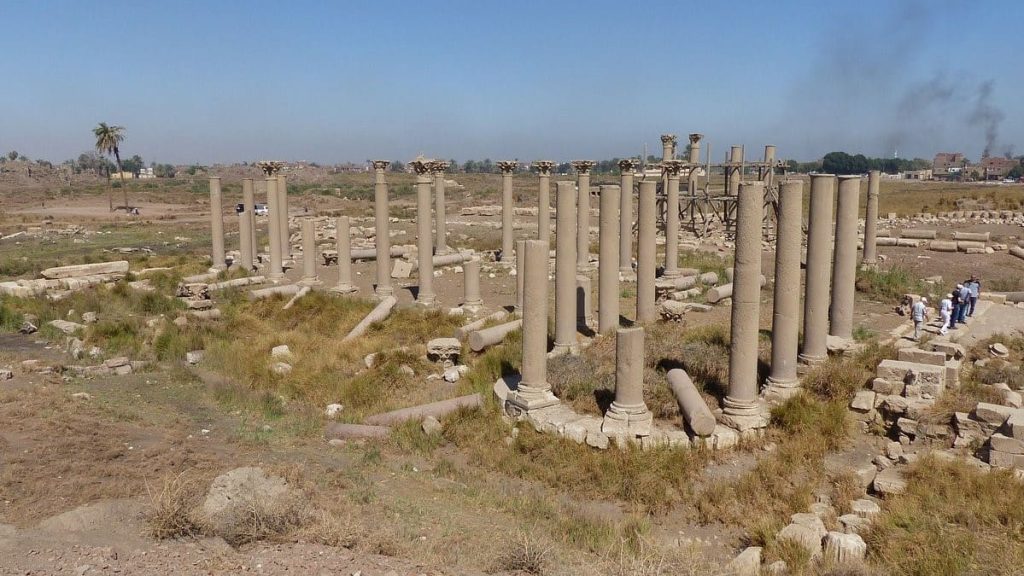
Tuna Al-Gabal
Facts: This site is notable for being a necropolis with a range of tombs, including the burial site of the god Thoth in baboon form.
Historical Background: It was most active during the Late Period and Greco-Roman times and is known for the catacombs of the animal mummies.
Location: Near the modern town of Mallawi, south of Al Minya.
Condition: The site is generally well-preserved, with ongoing efforts to maintain its integrity.
New Updates: Recent excavations have revealed a collection of mummies and a wide array of funerary artifacts.
Al Hamameya
Facts: Known for its ancient quarry sites, Al Hamameya was a source for construction materials used in temples and other structures throughout Egypt.
Historical Background: The quarrying activities here date back to the Pharaonic era.
Location: Close to the town of Sohag, in Upper Egypt.
Condition: Remains largely an archaeological site with fewer structures, highlighting the industrial aspect of ancient Egyptian civilization.
New Updates: Currently, there are limited ongoing excavations, with the focus on understanding the quarrying techniques of ancient builders.
Al Zayan Temple
Facts: This is one of the lesserknown small temples with limited public information.
Historical Background: Likely dates to the Greco Roman period, given the common temple construction activities during this era.
Location: Specific location details are scarce; further research and excavation are needed.
Condition: Due to its obscurity, the condition is not widely documented.
New Updates: Any recent discoveries or excavations have not been widely publicized.
Wekalet Al-Ghouri
Facts: Not an ancient site, but an important historical and cultural center from the Islamic era, built during the reign of Sultan Qansuh AlGhouri.
Historical Background: A “Wekalet” is a caravanserai or inn that historically hosted traders and travelers.
Location: Situated in the heart of Islamic Cairo, near the famous Khan ElKhalili bazaar.
Condition: It has been restored and is in good condition; currently serves as a cultural center hosting various events and performances.
New Updates: It’s an active cultural venue, especially known for Sufi whirling performances.
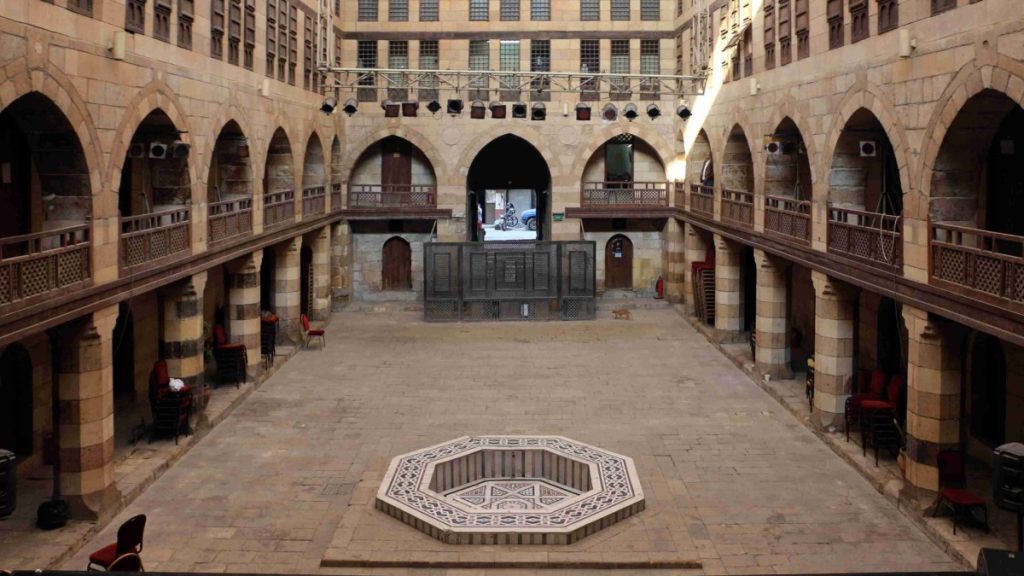
Al-Ghuri Collection: The Dome, the Path, and the House
Location & Historical Background: Nestled in the heart of Islamic Cairo, the Al-Ghuri Complex was built by the Mamluk Sultan Qansuh al-Ghuri in the early 16th century. The collection includes a mosque, a mausoleum (the Dome), a khanqah (a Sufi establishment), and a madrasa (Islamic school), illustrating the architectural and cultural zenith of the Mamluk period.
Condition: Well-preserved, this complex is a fine example of Islamic architecture, featuring intricate decorations and craftsmanship.
New Updates: It often hosts cultural events and Sufi nights, bringing the historical setting alive with Egyptian folklore and spiritual music.
Al-Mualla Temple
Location & Historical Background: Located in Upper Egypt, near Aswan, the Temple of Al-Mualla is an ancient Egyptian necropolis. It’s less known than other Egyptian sites, offering a glimpse into the practices and art of ancient Egypt outside the more famous locations.
Condition: It remains in a relatively preserved state, though not as restored as more prominent sites. Its isolation helps maintain its authenticity.
New Updates: As a less-visited site, it doesn’t frequently receive updates but remains an intriguing spot for those interested in the depths of Egypt’s ancient civilizations.
Al-Suhaimi’s House
Location & Historical Background: Al-Suhaimi’s House is located in the historic district of Islamic Cairo. Built in the late 17th century, it represents the living quarters of wealthy Cairo families during the Ottoman period. It’s an exquisite example of Islamic architecture and domestic life.
Condition: This house has been meticulously restored and now serves as a museum, offering insights into the social and architectural history of the period.
New Updates: It often hosts cultural events and educational programs, making it a vibrant part of Cairo’s cultural scene.
Ali Labib’s House
Location & Historical Background: This location is less well-documented in widely accessible resources, suggesting it might be a lesser-known site of historical or cultural significance within Egypt.
Condition & New Updates: Information on its current condition or any recent updates might be scarce online. It could be a private residence or a site not widely recognized in public tourism resources.
Amada Area
Location & Historical Background: The Amada area, in the Nubian region near Lake Nasser, is renowned for hosting the oldest Egyptian temple in Nubia, originally constructed by Pharaoh Thutmose III and later embellished by Amenhotep II. It’s celebrated for its age-old wall carvings and inscriptions.
Condition: Relocated to save it from the flooding caused by Lake Nasser, the temple is in a preserved state, keeping its historical integrity intact.
New Updates: As a significant part of Nubia’s heritage, it continues to draw visitors with its ancient allure and historical significance, though no major new updates have been announced recently.
Antiquities of Rosetta City
Location & Historical Background: Rosetta (Rashid), a port city on the Mediterranean coast in Egypt, is famous for the Rosetta Stone, which was instrumental in deciphering Egyptian hieroglyphs. The city is rich in architectural heritage, showcasing a mix of Ottoman and French styles.
Condition: Many of the historic houses and monuments are in various states of preservation, with ongoing efforts to restore and maintain this unique cultural heritage.
New Updates: The city often sees initiatives to boost tourism and awareness of its historical importance, including museum exhibitions and cultural events focusing on its rich past and the story of the Rosetta Stone.
(Esna Temple)
Location & Historical Background: Located in the city of Esna, south of Luxor, the Temple of Khnum is dedicated to the ram-headed god Khnum, the god of creation and the Nile. This partially excavated temple is sunk several meters below the current ground level of Esna.
Condition: The hypostyle hall, noted for its beautifully carved and painted columns, is the main part accessible today. It has been well preserved, offering a glimpse into the religious practices of the Ptolemaic and Roman periods in Egypt.
New Updates: Conservation efforts continue to protect and reveal more of the temple’s original splendor, including cleaning and restoration of the intricate inscriptions and ceiling carvings.
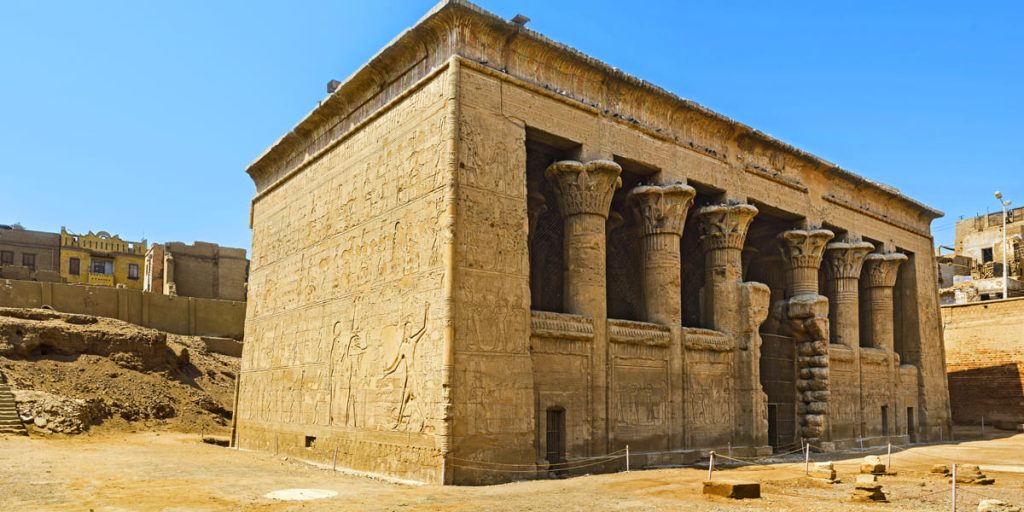
Bab Zewila
Location & Historical Background: Bab Zuweila is one of the three remaining gates in the walls of the Old City of Cairo, Egypt, dating back to the Fatimid era in the 11th century. It’s a significant landmark that once marked the southern boundary of the city.
Condition: Bab Zuweila has been well-preserved and is notable for its towering minarets, which are accessible to visitors and offer panoramic views of Cairo.
New Updates: The gate and its surroundings continue to be a focal point for cultural and historical tours, with no major new updates but ongoing maintenance to preserve its condition.
Baron Palace
Location & Historical Background: The Baron Empain Palace, located in the Heliopolis district of Cairo, is an architectural marvel built in the early 20th century by Belgian industrialist Édouard Louis Joseph, Baron Empain. The palace is designed in a distinctive Indian style and has recently been restored.
Condition: After years of neglect, the palace has undergone extensive restoration and was reopened to the public in 2020.
New Updates: The reopening of the palace allows visitors to explore its architectural beauty and the history of Heliopolis, with the interior and gardens now accessible.
Carter House
Location & Historical Background: Located near the Valley of the Kings in Luxor, Carter House is the former residence of Howard Carter, the archaeologist who discovered the tomb of Tutankhamun in 1922. The house now serves as a museum.
Condition: The house is well-preserved, offering a glimpse into the life of Carter and the discovery of Tutankhamun’s tomb.
New Updates: A replica of Tutankhamun’s tomb has been created near the house to give visitors a sense of the original excavation and discovery, without the need to visit the actual tomb, thus aiding in its preservation.
Dabaa and Ain Aseel Castles
Location & Historical Background: These castles are located in the Matrouh Governorate on the Mediterranean coast. They are part of a series of fortifications that date back to different eras, including the Roman and Islamic periods, serving as strategic military forts.
Condition: Information on their current condition is limited, suggesting they are less visited and might not be as well-preserved as more prominent historical sites in Egypt.
New Updates: Given their historical significance, there may be local efforts to study and possibly restore these sites, but specific updates are not widely documented.
Dahshur area
Condition: The Dahshur area is relatively well-preserved, with ongoing archaeological work to uncover more of its history and to maintain the integrity of the pyramids.
New Updates: The site has seen increased accessibility for tourism in recent years, with the opening of the Bent Pyramid to the public in 2019, allowing visitors to enter its chambers.
Location & Historical Background: Dahshur is a royal necropolis located in the desert on the west bank of the Nile approximately 40 kilometers south of Cairo. It is known for several pyramids, including the Bent Pyramid and the Red Pyramid, built during the reign of Pharaoh Sneferu (2613-2589 BCE).
These sites represent a cross-section of Egypt’s vast historical landscape, from ancient royal necropolises and iconic city gates to the homes of modern archaeologists and the palatial residences of early 20th-century expatriates. Each holds a unique place in Egypt’s cultural and historical narrative, offering insights into different epochs and the ever-evolving story of this cradle of civilization.
Dahshur Area
Location & Historical Background: Situated about 40 km south of Cairo, Dahshur is a necropolis in the Memphis area and is home to some of Egypt’s oldest, largest, and best-preserved pyramids, including the Bent Pyramid and the Red Pyramid, both built during the reign of Pharaoh Sneferu (around 2600 BC).
Condition: Dahshur is relatively less visited compared to Giza, offering a more serene experience. The condition of the pyramids and surrounding area is well-maintained, preserving the integrity and grandeur of these ancient structures.
New Updates: The area has seen increased accessibility and conservation efforts, including the recent opening of the Bent Pyramid to the public.
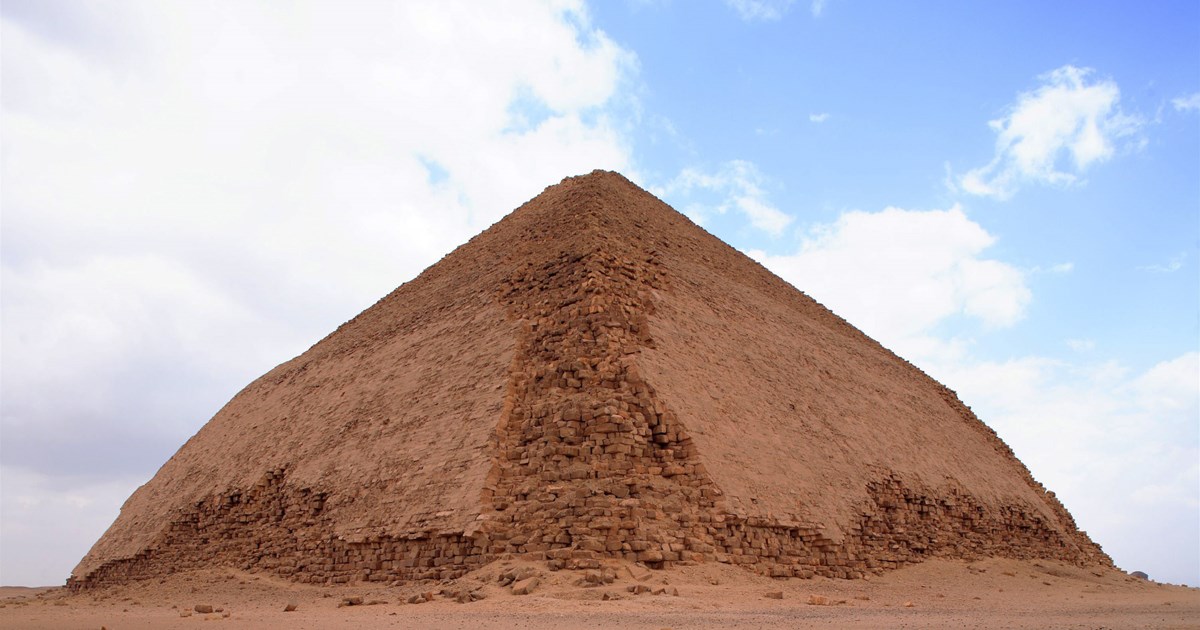
Deir el-Medina
Location & Historical Background: Located on the west bank of the Nile, opposite Luxor, Deir el-Medina is an ancient Egyptian village which was home to the artisans who worked on the tombs in the Valley of the Kings during the 18th to 20th dynasties of the New Kingdom period (1550-1080 BC).
Condition: The site is remarkably well-preserved, offering unique insights into the daily lives of the workers and their community, including their homes, tombs, and the temple dedicated to Hathor.
New Updates: Ongoing archaeological work continues to uncover new findings, adding depth to our understanding of ancient Egyptian social and religious practices.
Dendera Temple Panorama
Location & Historical Background: The Temple of Dendera, located about 2.5 km southeast of Dendera, Egypt, is one of the best-preserved temple complexes in Egypt. Dedicated to the goddess Hathor, the temple showcases the grandeur of late Egyptian architecture.
Condition: The complex, particularly the Temple of Hathor, is in excellent condition, with many of its structures, reliefs, and hieroglyphs intact. The ceiling’s astronomical representations are especially notable.
New Updates: Efforts to clean and restore the temple have revealed original colors and details previously obscured, enhancing its stunning visual impact for visitors.
Dosh Temple
Location & Historical Background: Information on Dosh Temple is not widely documented in standard references, which may suggest it’s a less-known site, possibly confused with or referred to by another name in specific scholarly or local contexts.
Condition & New Updates: Due to the ambiguity around the site, detailed current conditions and updates are not readily available. It would be beneficial to consult specialized archaeological resources or local experts for accurate information.
El Bagawat
Location & Historical Background: El Bagawat is an ancient Christian cemetery, one of the oldest in the world, located in Kharga Oasis in the Western Desert. It dates back to the 3rd century AD, featuring chapels with mud-brick walls and fascinating biblical scenes.
Condition: The site is in a relatively good state of preservation, with some of the chapels still featuring original paintings and inscriptions, offering a rare glimpse into early Christian burial practices.
New Updates: Conservation efforts are ongoing to preserve the paintings and structures against the elements, though the remote location means updates may not be as frequent as more accessible sites.
Each of these locations represents a unique chapter in Egypt’s extensive history, from the ancient funerary practices of Dahshur and Deir el-Medina to the religious expressions at El Bagawat and the architectural splendor of the Dendera Temple. While some sites like Dosh Temple may require further exploration to uncover their stories, the depth and diversity of Egypt’s cultural heritage are unmistakably vast, continuing to captivate and educate the world.
EL Hawawesh
Location & Historical Background: El Hawawesh is situated in the Sohag Governorate and is known for its ancient necropolis, part of the larger area of Akhmim. It served as a burial site during various periods of ancient Egypt, showcasing a range of tombs from different dynasties.
Condition: The site, though less frequented by tourists compared to Egypt’s more famous necropolises, contains tombs that offer insight into the architectural and artistic styles of ancient Egyptian burial practices.
New Updates: Archaeological studies and preservation efforts are ongoing, though specific recent updates might not be widely publicized outside of academic circles.
El Selssela (The Chain) Mount
Location & Historical Background: El Selssela Mount is located near the town of Edfu, along the Nile. Historically, this site was renowned for its quarries, which supplied sandstone for many ancient Egyptian temples. The name “The Chain” derives from a chain that was stretched across the Nile as a defensive measure.
Condition: Today, it offers visitors a glimpse into the monumental task of quarrying stone in the ancient world, with remnants of tools and carved inscriptions left by the workers.
New Updates: While the historical significance remains, there aren’t typically new updates in terms of developments or discoveries, given its nature as an ancient quarry site.
Elephantine Island
Location & Historical Background: Elephantine Island is located in the Nile River, at Aswan. This strategic and sacred site was one of ancient Egypt’s most important cities, known for its ivory trade. It hosts significant archaeological remains, including temples dedicated to Khnum and several other deities, as well as a nilometer for measuring the Nile’s floodwaters.
Condition: The island is well-maintained, with ongoing archaeological work revealing more about its rich past. Its layers of history are accessible to visitors, showcasing a blend of cultural influences over millennia.
New Updates: Recent excavations continue to uncover new artifacts and structures, enriching our understanding of ancient Egyptian, Nubian, and later periods.
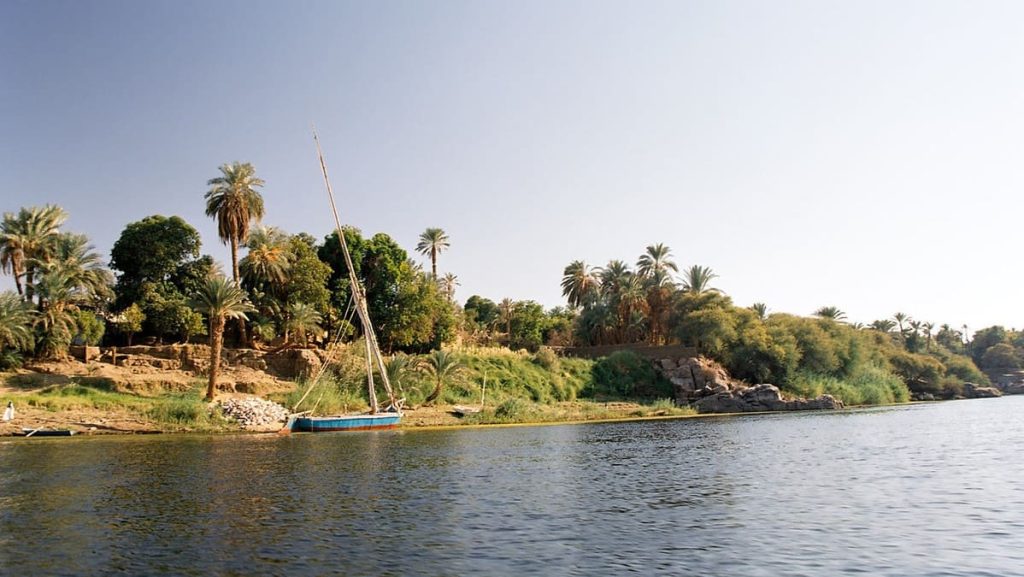
Ezba Bashandi
Location & Historical Background: Ezba Bashandi is a lesser-known locale that might refer to a rural area or small community within Egypt. Specific historical or cultural significance tied to this name is not widely documented in general sources.
Condition & New Updates: Without clearer identification, it’s challenging to provide detailed information about its condition or any recent updates. It may be a site of local interest rather than a tourist destination.
Giza Pyramids Area
Location & Historical Background: The Giza pyramid complex, on the outskirts of Cairo, is one of the most iconic archaeological sites worldwide. It includes the Great Pyramid of Giza, one of the Seven Wonders of the Ancient World, along with the pyramids of Khafre and Menkaure, and the Great Sphinx.
Condition: This UNESCO World Heritage site is well-preserved and continuously maintained, despite the challenges of urban encroachment and tourism pressures.
New Updates: The Giza Plateau has seen several recent developments to improve tourist facilities and access, including the Grand Egyptian Museum’s upcoming opening, intended to showcase Egypt’s ancient treasures in a state-of-the-art facility near the pyramids.
Each of these sites—from the ancient quarries of El Selssela to the monumental splendor of the Giza Pyramids—offers a unique window into Egypt’s complex layers of history, culture, and natural beauty. Whether it’s through ongoing archaeological discoveries or the preservation of its timeless monuments, Egypt continues to reveal stories that have shaped humanity’s shared heritage.
Hawara Pyramid
Location & Historical Background: The Hawara Pyramid is located near the site of Crocodilopolis (Arsinoe), in the Faiyum Oasis. Built by Amenemhat III during the 12th Dynasty of the Middle Kingdom (around 1855-1808 BCE), it is known for its distinctive mudbrick core and limestone casing, which is largely gone now.
Condition: The pyramid itself has suffered from time and looting, leaving it in a state of ruin, but the complex’s layout, including the labyrinth once described by Herodotus, can still be discerned.
New Updates: Archaeological efforts continue in the area, aiming to uncover more about the pyramid’s construction and the legendary labyrinth.
Hibis Temple
Location & Historical Background: Located in the Kharga Oasis, Hibis Temple is the largest and best-preserved temple in the oasis, dedicated to Amun and dating back to the Persian period (6th century BCE), with additions by later Ptolemaic and Roman rulers.
Condition: The temple is in a remarkable state of preservation, offering vivid examples of religious art, including well-preserved wall paintings and carvings.
New Updates: Conservation projects have focused on preserving and studying the complex iconography and inscriptions found within the temple.
House Al-Harawi
Location & Historical Background: Also known as Beit Al-Harrawi, this house is located in Cairo’s historic district. It dates back to the Ottoman period and is an example of the grand homes built during this era. It’s often associated with cultural events and traditional music.
Condition: The house has been restored and is maintained as part of Cairo’s efforts to preserve its Islamic architectural heritage.
New Updates: It occasionally hosts cultural events and concerts that showcase traditional Egyptian and Islamic arts, keeping the cultural essence of the period alive.
House ELSET WASELH
Location & Historical Background: This site appears to have a less clear presence in widely available English-language sources, suggesting it might be a lesser-known or locally known historical site or residence in Egypt. Without specific details, it’s challenging to provide a concise introduction.
Condition & New Updates: Due to the ambiguous nature of the reference, information on the current condition and any recent updates is not readily available.
Isis Temple & Deir Shelwit
Location & Historical Background:
Isis Temple is located on the island of Philae near Aswan. The temple was dedicated to the goddess Isis and is part of a larger complex of structures relocated to Agilkia Island as part of a UNESCO project to save them from flooding caused by the Aswan Dam.
Deir Shelwit is a standalone temple located near Luxor, dedicated to the goddess Isis. This small and less frequented site dates back to the Roman period and offers insights into the religious practices of the time.
Condition: Isis Temple is in excellent condition, with ongoing efforts to preserve its stunning reliefs and architecture.
Deir Shelwit remains relatively well-preserved but is not as extensively restored or maintained as more prominent sites.
New Updates:
Isis Temple continues to be a focus of both scholarly research and tourism development, enhancing visitor experiences while preserving the site.
Deir Shelwit sees fewer updates but remains an important site for understanding the breadth of ancient Egyptian religious life.
These sites span from the architectural wonders of ancient pyramids to the intimate details of religious life and the grandeur of Ottoman residences, each offering a unique glimpse into the many layers of Egypt’s history and cultural evolution.
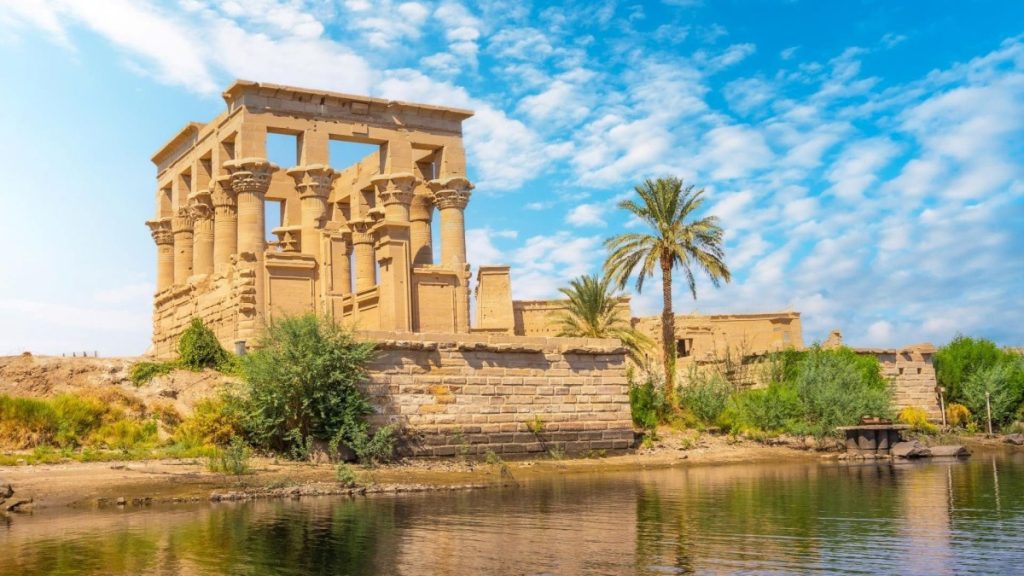
Kalabsha Temple
Location & Historical Background: This temple is situated near Aswan, on the west bank of Lake Nasser. Originally built in Nubia, around 30 BCE during the Roman occupation, it was dedicated to the Nubian god Mandulis. The temple is a fine example of Roman Egyptian architecture and art.
Condition: Kalabsha Temple was moved to its current location to avoid being submerged by Lake Nasser after the construction of the Aswan High Dam. Today, it stands well-preserved, offering insight into the religious practices of the time.
New Updates: The temple is a focus for studies on Nubian culture and religion, with ongoing preservation efforts to maintain its condition.
Karanis Area
Location & Historical Background: Karanis, or Kom Aushim, is located in the Fayoum Oasis. Founded during the Ptolemaic period in the 3rd century BCE, it flourished through the Roman period as an agricultural community. The site includes remnants of houses, temples, and granaries.
Condition: The ruins at Karanis provide a valuable insight into Greco-Roman life in Egypt. The site is partially excavated, with ongoing archaeological work.
New Updates: Recent excavations continue to reveal more about daily life in ancient Karanis, with findings contributing to our understanding of agriculture, economy, and domestic activities in the region.
Lahoun Pyramid
Location & Historical Background: The pyramid is located near the village of El-Lahun, in the Faiyum Oasis. Built by Pharaoh Senusret II of the 12th Dynasty (around 1882-1872 BCE), it features a mudbrick core with a limestone casing, now largely removed.
Condition: Unlike the more famous pyramids of Giza, the Lahoun Pyramid is less visited and remains in a state of ruin, though its unique construction techniques and the surrounding complex offer important insights into Middle Kingdom pyramid construction.
New Updates: Archaeological efforts in the area focus on the surrounding burial complexes and the town that housed the workers who built the pyramid.
Luxor Museum
Location & Historical Background: Located on the east bank of the Nile in Luxor, the museum houses artifacts from the Theban temples and necropolis, offering a comprehensive overview of the ancient city’s history from the Old Kingdom through the Islamic period.
Condition: The museum is in excellent condition, known for its modern design and the quality of its exhibits. It provides a quiet, contemplative environment to appreciate the artifacts.
New Updates: The museum continuously updates its exhibits and recently introduced new items discovered in Luxor, ensuring that its collection remains dynamic and reflective of the latest archaeological findings.
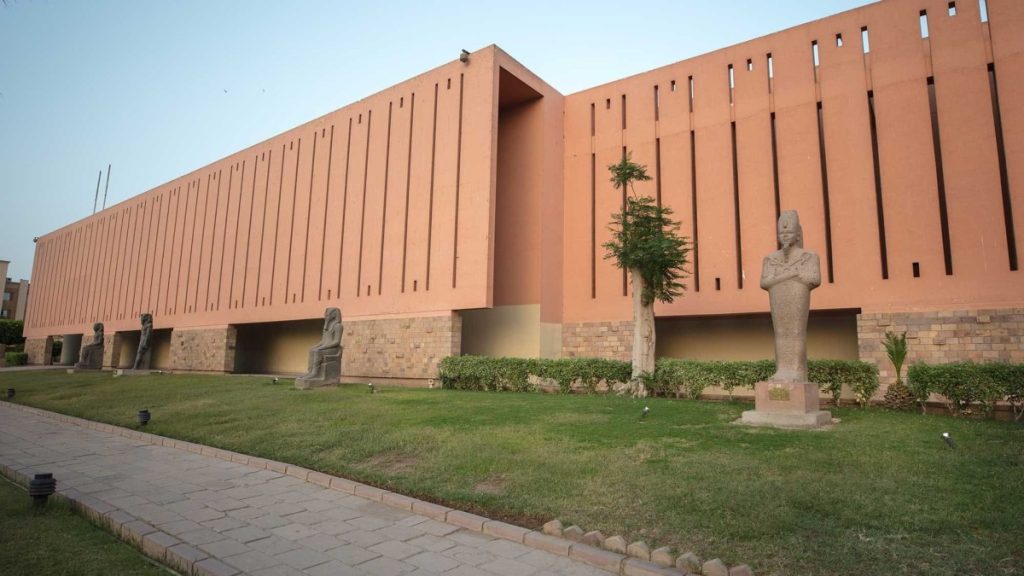
Madi City
Location & Historical Background: Madi (often referred to as El Madī or Medinet Madi) is located in the Faiyum Oasis. It is renowned for its archaeological site, which features the ruins of an ancient city and a temple dedicated to the crocodile god Sobek, dating back to the Middle Kingdom and the Ptolemaic period.
Condition: The site has seen various phases of excavation and preservation, revealing structures that include a Middle Kingdom temple complex as well as Ptolemaic and Roman period ruins.
New Updates: Ongoing archaeological work continues to uncover and preserve the remnants of this ancient city, providing deeper insights into its historical significance.
Malawi Museum
Location & Historical Background: Situated in Minya, Egypt, the Malawi Museum held a diverse collection of artifacts spanning various periods of Egyptian history, from ancient times through to the Islamic era.
Condition: The museum suffered significant damage and looting in 2013, resulting in the loss of many artifacts. Efforts have been made to recover lost items and restore the museum.
New Updates: Restoration and recovery efforts are ongoing, with some artifacts having been successfully retrieved and returned to the museum. The institution is working towards resuming its role as a cultural and educational hub.
Mary’s Tree
Location & Historical Background: Mary’s Tree, located in Matariya, a suburb of Cairo, is believed to be the site where the Holy Family rested during their flight into Egypt. The site is marked by an ancient sycamore tree, or a descendant of the original, which is considered sacred.
Condition: The site is well-maintained, serving as a pilgrimage destination for Christians visiting Egypt. The area around the tree has been developed to accommodate visitors.
New Updates: The site continues to attract visitors and pilgrims, with ongoing efforts to ensure its preservation and accessibility.
Takeyya Mawlawiyya
Location & Historical Background: The Mawlawiyya Hospice, associated with the Mawlawi Sufi order, is notable for its historical and cultural significance within the Islamic world, particularly in Egypt. Locations associated with the Mawlawiyya can vary, with historical hospices found in Cairo and other cities.
Condition: Specifics can vary depending on the location, but many of these sites have been preserved for their cultural and religious importance, often hosting ceremonies and cultural events.
New Updates: With a renewed interest in Sufi traditions and culture, some of these hospices may host events or undergo restoration to serve both religious and cultural interests.
Maydeum Pyramid
Location & Historical Background: The Maydeum (or Meidum) Pyramid is located in Lower Egypt, near the Faiyum Oasis. Initially built for Pharaoh Huni and then continued by Sneferu, the pyramid represents a transitional form between step-sided and smooth-sided pyramids.
Condition: Today, the pyramid appears more as a tower due to the outer layers having fallen away, revealing its core structure. The site includes the pyramid itself and several mastabas (flat-roofed burial structures) surrounding it.
New Updates: Archaeological studies continue to explore the construction techniques and historical context of the pyramid, contributing to our understanding of the evolution of pyramid building in ancient Egypt.
Each of these sites contributes to the rich mosaic of Egypt’s heritage, from ancient cities and pyramids to places of religious significance and cultural preservation. Their ongoing study and conservation efforts help to deepen our understanding of Egypt’s past and present.
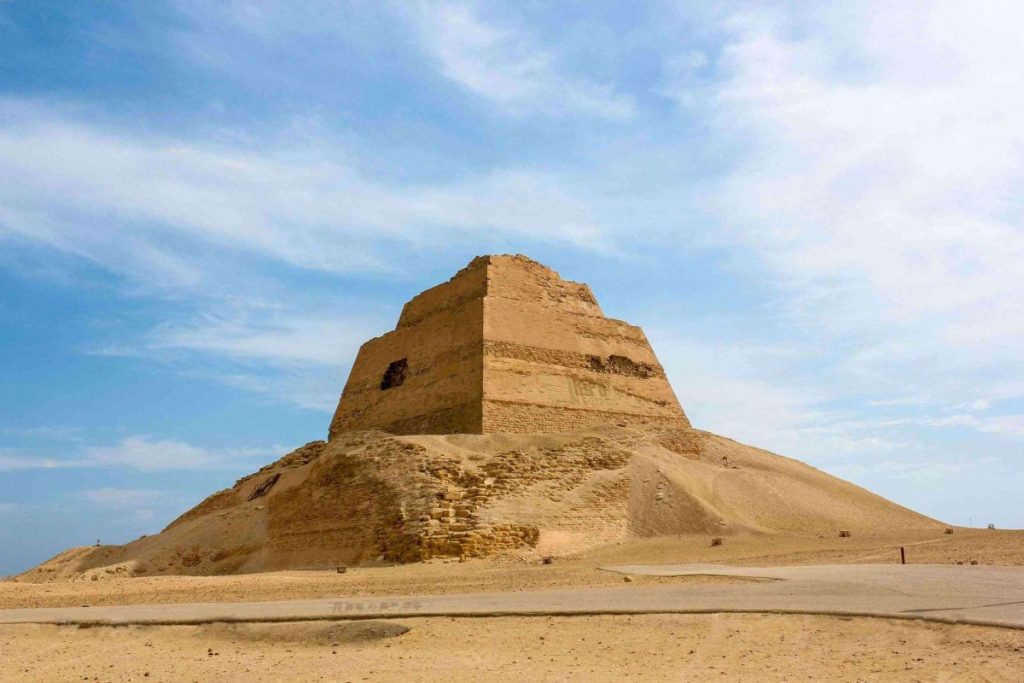
Merneptah Temple
Location & Historical Background: Located in the West Bank of Luxor, the Merneptah Temple was constructed by Pharaoh Merneptah, the fourth ruler of the 19th Dynasty, who reigned from 1213 to 1203 BCE. The temple is part of the larger Theban necropolis and is dedicated to Merneptah, son of the renowned Pharaoh Ramses II.
Condition: Though not as well-preserved as other monuments in Luxor, significant portions of the temple, including its walls and some structures, remain. It provides valuable insights into the construction and art of the period.
New Updates: Archaeological efforts continue to reveal more about the temple’s layout and function, contributing to the broader understanding of the Theban necropolis.
Mit Rahina Area
Location & Historical Background: Mit Rahina is the modern name for the ancient Egyptian capital of Memphis, located near the town of Badrashin, approximately 20 km south of Cairo. As the ancient capital, it was a cultural and religious center, home to the temple of Ptah, among others.
Condition: Today, Mit Rahina is an open-air museum featuring various statues, including the colossal statue of Ramses II, and remnants of temples and other structures.
New Updates: Ongoing excavation and preservation projects aim to uncover more of this once-vast city, gradually piecing together its layout and importance in ancient Egypt.
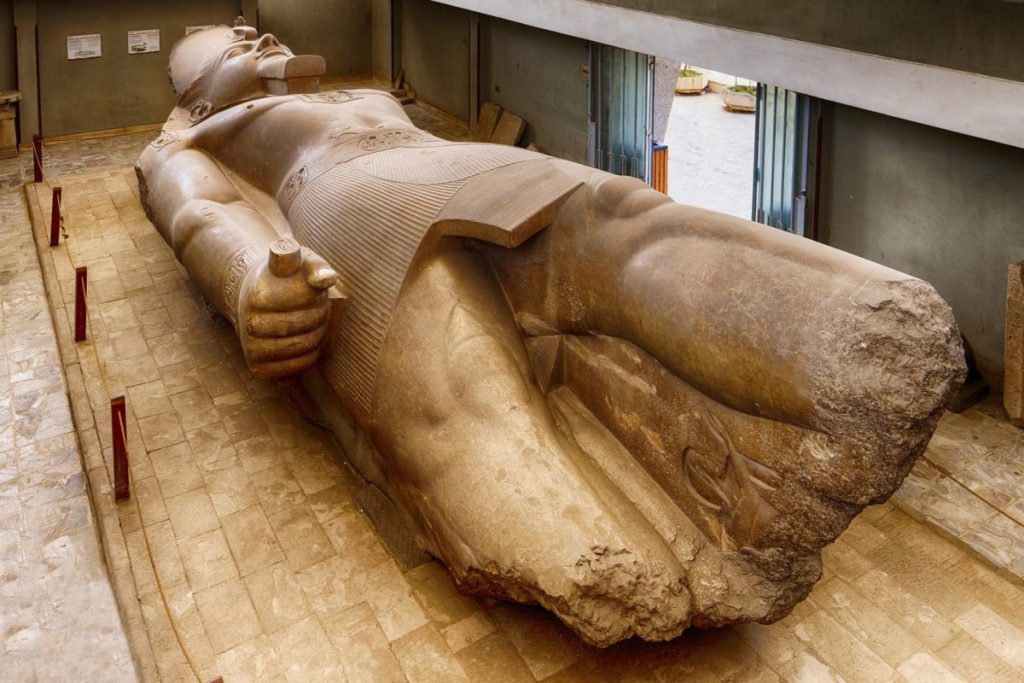
Moez Street
Location & Historical Background: Al-Moez Ldin Allah Al-Fatimi Street, commonly known as Moez Street, is located in the heart of historic Cairo. It is one of the oldest streets in Cairo, rich in Islamic architecture, and spans from Bab Al-Futuh in the north to Bab Zuweila in the south.
Condition: The street and its surrounding area have been the focus of extensive restoration and revitalization projects, making it a vibrant showcase of Islamic Cairo’s heritage.
New Updates: It now functions as an open-air museum and is a popular destination for both tourists and Egyptians, featuring shops, cafés, and cultural events that celebrate Egypt’s Islamic heritage.
Muhammad Ali Palace in Manial
Location & Historical Background: Situated on Rhoda Island in Cairo, the Manial Palace was built by Prince Mohammed Ali Tewfik between 1899 and 1929. The palace complex reflects a blend of Ottoman, Persian, and Moorish architectural styles, set within beautiful gardens.
Condition: The palace and its gardens have been well-preserved and are open to the public as a museum, offering a glimpse into the lavish lifestyle of Egyptian royalty in the early 20th century.
New Updates: The museum continues to attract visitors with its unique architectural and historical significance, and it hosts various cultural and educational events.
Muhammad Ali Palace in Shubra (opening soon)
Location & Historical Background: The Shubra Palace, also associated with Muhammad Ali Pasha, is located in the Shubra district of Cairo. Built in the early 19th century, it is one of the earliest examples of the integration of European architectural styles into Egyptian architecture.
Condition: The palace has undergone extensive restoration to return it to its former glory, preserving its unique blend of architectural styles.
New Updates: Anticipation surrounds its reopening, expected to further enrich Cairo’s cultural and historical landscape by providing access to another splendid example of Egypt’s diverse architectural heritage.
Each site, from the ancient ruins of Merneptah Temple to the architectural splendors of the Muhammad Ali Palaces, encapsulates a different facet of Egypt’s rich tapestry of history, offering visitors a journey through time across dynasties, cultures, and traditions.
New Valley Museum
Location & Historical Background: Located in Kharga Oasis, within the New Valley Governorate of Egypt, the New Valley Museum offers a glimpse into the history and culture of the oasis and the Western Desert. The museum showcases artifacts from the prehistoric period to the Islamic era, highlighting the diversity of the region’s history.
Condition: The museum is well-maintained, providing visitors with both indoor and outdoor exhibit spaces that include statues, pottery, and other archaeological finds.
New Updates: While specific recent updates may not be widely publicized, the museum continually aims to enhance its collections and displays to better represent the history of the New Valley and its surrounding areas.
Nilometer
Location & Historical Background: Nilometers were ancient Egyptian devices used to measure the Nile River’s water level during its annual flood, crucial for predicting the agricultural season’s success. One of the most famous Nilometers is located on Rhoda Island in Cairo. It dates back to the Islamic period, although the practice of measuring the Nile’s levels began in Pharaonic times.
Condition: The Rhoda Island Nilometer is well-preserved, offering visitors the chance to see an ancient scientific instrument that played a vital role in Egypt’s agricultural and economic life.
New Updates: As a protected historical site, the Nilometer doesn’t undergo significant changes, but it remains an important educational and tourist attraction, reflecting Egypt’s advanced ancient technologies and their relevance to the country’s prosperity.
Obelisk
General Overview: Obelisks are tall, four-sided, narrow tapering monuments with a pyramidion on top, originating in ancient Egypt. They were typically erected in pairs at the entrances of temples and are inscribed with hieroglyphs that honor the pharaohs and their achievements. Many obelisks were transported from Egypt to cities around the world in the 19th and 20th centuries.
Specific Example – The Obelisk of Luxor: Located in the center of the Place de la Concorde in Paris, France, this obelisk originally stood at the entrance to the Luxor Temple in Egypt. It was gifted to France in the 19th century.
Condition: Most of the obelisks, whether in Egypt or abroad, are well-preserved, standing as testaments to ancient Egyptian engineering and religious beliefs.
New Updates: While the obelisks themselves don’t receive updates, the methods for preserving them and the surrounding infrastructure may be updated to ensure their preservation and integration into modern urban landscapes.
Each of these, from the New Valley Museum’s cultural treasures to the technological marvel of the Nilometer and the grandeur of ancient obelisks, showcases a different aspect of Egypt’s multifaceted heritage, blending history, science, and art in a narrative that spans millennia.
Continuing the Journey: Discover More Places in Egypt Spiritual Landscape
As we wrap up our epic journey through the monumental historical sites of Egypt, each moment spent among these ancient wonders has felt like stepping back into the pages of history. From the awe-inspiring pyramids that punctuate the skyline to the intricate carvings that tell tales of epochs long past, Egypt offers an unparalleled glimpse into a world that has shaped human civilization.
Our exploration doesn’t stop here. As the Nile seamlessly threads through Egypt’s landscape, our journey naturally flows towards its spiritual heart. Immerse yourself in the serenity and sanctity of sacred spaces where history meets spirituality. Discover the majestic temples dedicated to ancient gods, and the tranquil mosques resonating with contemplative prayers. For more temples & mosques to visit in Egypt, click here.
Prepare to explore these realms where spiritual heritage has been preserved for centuries. Let the past inspire your future travels as we venture into the spiritual landscapes of Egypt.

Faris is the passionate founder of Travel2Egypt, deeply connected to Aswan’s essence. He aims to share the true heart of Egypt through its rich history, vibrant culture, and the warmth of its people. Join Faris to experience the magic of Aswan beyond the usual tourist paths.

